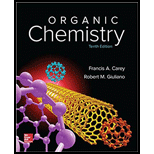
Concept explainers
(a) An aqueous solution containing
(b) If this solution were mixed with
Interpretation:
The specific rotation of fructose is to be calculated and the specific rotation of the resulting fructose mixture and its optical rotation is to be calculated.
Concept introduction:
The specific rotation, denoted by
Here,
The optical purity is numerically equal to the percentage enantiomeric excess, which can be determined from the following expression:
The percent enantiomeric excess is the difference between the percentages of each enantiomer.
It can also be calculated according to the following equation:
Where
Mixtures containing equal quantities of enantiomers are called racemic mixtures.
Answer to Problem 43P
Solution:
a) The specific rotation of optically pure fructose is
b) The specific rotation of resulting fructose mixture is
Explanation of Solution
a) Calculation for specific rotation of fructose.
Calculating the concentration of the sample solution as follows:
Now, calculate the length of the polarimeter tube as follows:
The specific rotation for the optically pure enantiomer can be calculated below:
Substitute the required values in the above equation.
Hence the specific rotation of optically pure fructose is
b) The amount of racemic mixture added is
The amount of fructose present as pure enantiomer is
The racemic mixture contains equal amounts of both the enantiomers. The total amount of pure enantiomer is calculated below.
Combined amount of the pure enantiomer is
Thus, the amount of the other enantiomer is
Total volume of solution is
The concentration of the pure enantiomer is calculated as follows:
The concentration of the other enantiomer is calculated as follows:
The enantiomeric excess is given by the expression as follows:
Substitute the required values in the above equation.
Optical purity is equal to the enantiomeric excess. Thus, the specific rotation of the sample is calculated using the following formula given below.
Here, the specific rotation of pure enantiomer of fructose is
Hence the specific rotation of resulting fructose sample is
Want to see more full solutions like this?
Chapter 4 Solutions
ORGANIC CHEMISTRY-W/STUD.SOLN.MAN.
- How many asymmetric carbons and stereoisomers are there for an aldohexose? For aketohexose?arrow_forward1. When 0.247 g of monosodium glutamate (MSG) is dissolved in 10.0 mL of water and placed in a sample cell 10.0 cm in length, the observed rotation at 20°(using the D line of sodium) is +0.632°. Calculate the specific rotation of MSG. 2. When 0.095 g of cholesterol is dissolved in 1.00 mL of ether and placed in a sample cell 10.0 cm in length, the observed rotation at 20°C (using the D line of sodium) is -0.299°.Calculate the specific rotation of cholesterol.3. The specific rotation of L-dopa in water (at 15°C) is -39.5. A chemist prepared a mixture of L-dopa and its enantiomer, and this mixture had a specific rotation of -34. Calculate the % ee of this mixture. 4. The specific rotation of vitamin B7 in water (at 22°C) is +92. A chemist prepared a mixture of vitamin B7 and its enantiomer, and this mixture had a specific rotation of +18. Calculate the % ee of this mixture.arrow_forwardWhat do the peaks of C6H12O2 show?arrow_forward
- It was C4H6O2arrow_forwardWhat type of stereochemistry, S or R, does the chiral center in this molecule have?arrow_forwardLook up the structures of the following carbohydrates: D-Fructose, Sucrose and Maltose. Write down the formula for the calculation of specific rotation given the observed rotation, path length and concentration of a chiral sample.arrow_forward
- The anticoagulant heparin is a polysaccharide that contains alternating residues of -D- glucuronic acid-6- sulfate and N-sulfo-D-glucosamine-6sulfate connected by (1 B 4)- glycosidic linkages. Draw a part of heparin that shows one each of the two residues.arrow_forwardwhat is the N factor of disodium ethylenediaminetetraacetate (C10H14N2Na2O8)?arrow_forwardThe following data was collected for this experiment: A sample of 0.8281 g of phenylsuccinic acid was dissolved in 10 mL of acetone. This sample gave a reading, aobs, of +10.278 deg on the polarimeter. A tube measuring 1 dm was used for the sample. What is the major enantiomer present in this sample? Calculate the concentration of the sample used in g/mL. Calculate the observed specific rotation [a]obs of the sample. Give your answer to 4 significant figures.arrow_forward
- Carbohydrates. Determination of the extent of branching in glycogen. The amount of branching (number of α 1⟶ 6 glycosidic bonds) in glycogen can be determined by the following procedure. A sample of glycogen is exhaustively methylated-treated with a methylating agent (methyl iodide) that replaces the hydrogen of every sugar hydroxyl with a methyl group, converting –OH to –OCH3. All the glycosidic bonds in the treated sample are then hydrolyzed in aqueous acid, and the amounts of α -D-2,3-di-O-methylglucopyranose and α -D-2,3,6-tri-O-methylglucopyranose formed are measured. 1- Draw the cyclic structure of α-D-glucopyranose, α-D-2,3-di-O-methylglucopyranose and α-D-2,3,6-tri-O-methylglucopyranose, including the numbering of carbon atoms. 2- Which of α-D-2,3-di-O-methylglucopyranose or α-D-2,3,6-tri-O-methylglucopyranose represents a glucose unit in glycogen which was originally carrying a α 1⟶ 6 glycosidic bond? Explain.arrow_forwardThe specific rotation of a-d-glucose is +112.2. Q.) When a-d-glucose is dissolved in water, the specific rotation of the solution changes from +112.2 to +52.7. Does the specific rotation of a-l-glucose also change when it is dissolved in water? If so, to what value?arrow_forwardCalculate the degree of unsaturation in each of the following formulas (a) Cholesterol, C27H46o (b) DDT, C14HgC15 (c) Prostaglandin E1, C2oH3405 (d) Caffeine, C8H10N402 (e) Cortisone, C21H28O5 (f) Atropine, C17H23NO3arrow_forward
 Introduction to General, Organic and BiochemistryChemistryISBN:9781285869759Author:Frederick A. Bettelheim, William H. Brown, Mary K. Campbell, Shawn O. Farrell, Omar TorresPublisher:Cengage Learning
Introduction to General, Organic and BiochemistryChemistryISBN:9781285869759Author:Frederick A. Bettelheim, William H. Brown, Mary K. Campbell, Shawn O. Farrell, Omar TorresPublisher:Cengage Learning Organic ChemistryChemistryISBN:9781305580350Author:William H. Brown, Brent L. Iverson, Eric Anslyn, Christopher S. FootePublisher:Cengage LearningChemistry: Matter and ChangeChemistryISBN:9780078746376Author:Dinah Zike, Laurel Dingrando, Nicholas Hainen, Cheryl WistromPublisher:Glencoe/McGraw-Hill School Pub Co
Organic ChemistryChemistryISBN:9781305580350Author:William H. Brown, Brent L. Iverson, Eric Anslyn, Christopher S. FootePublisher:Cengage LearningChemistry: Matter and ChangeChemistryISBN:9780078746376Author:Dinah Zike, Laurel Dingrando, Nicholas Hainen, Cheryl WistromPublisher:Glencoe/McGraw-Hill School Pub Co



